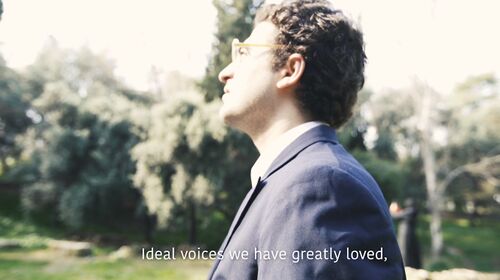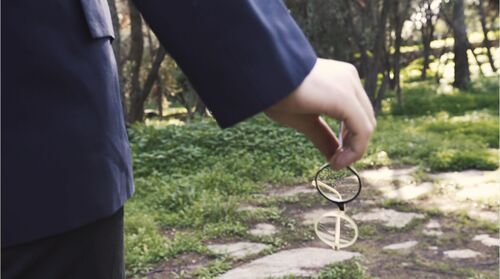Kavafis: Difference between revisions
No edit summary |
No edit summary |
||
| Line 11: | Line 11: | ||
According to Jakobson, poetry reading is a non linear reading process in which the reader is directed by the patterns of similarity and contrast. These patterns draw the reader’s attention while reading. This structure and palpable presence of language breaks the illusion of a direct relationship between linguistic and non-linguistic sign. By emphasizing the illusionary nature of the relationship between linguistic and non-linguistic signs and by situating the linguistic sign within a system of signs, a multiplicity of potential meanings is achieved within the poem.” | According to Jakobson, poetry reading is a non linear reading process in which the reader is directed by the patterns of similarity and contrast. These patterns draw the reader’s attention while reading. This structure and palpable presence of language breaks the illusion of a direct relationship between linguistic and non-linguistic sign. By emphasizing the illusionary nature of the relationship between linguistic and non-linguistic signs and by situating the linguistic sign within a system of signs, a multiplicity of potential meanings is achieved within the poem.” | ||
In addition, poetry certainly “begins in the images of the preconscious or subconscious mind and is filtered through language toward the precise symbols and syntax of an imaginative construction at first glimpsed only dimly by the poet”. | In addition, poetry certainly “begins in the images of the preconscious or subconscious mind and is filtered through language toward the precise symbols and syntax of an imaginative construction at first glimpsed only dimly by the poet”. | ||
'''Process''' | |||
Taking the nonlinear form of poetic language as a starting point, I chose to make a research in the work of the Greek poet Konstantinos Kavafis. Reading about his work and his life, I decided to make a short film about him. The way the poet lived his life, the methods he uses in his work as well as the situations he creates in his poems were essential for my choices during the making of the movie. The protagonists he place in his poems often appear in a form of vision, half real half illusion, as in a dream. This was an important point to place the poet in the movie, walking in a path, where scenes from his life, his work, his protagonists appear in a state of real-unreal. | |||
Other examples: | |||
- His protagonists are considered to be in the hands of fate and this is the way he creates the poem’s dramatic character. The deaths of Achilles and Sarpedon, Caesar and Nero, Mithridates and Aristoboulos, are glossed as exempla of fate’s mockery. Taking this element from his work, I placed Pythia ( the fortress of ancient Greece) to appear in his path, giving a symbolic sign. | |||
- Using the "mythical method", "does not just outline it," writes Seferis, "systematically applies it”. Kavafis myths the historical past and places in it modern analogous emotional states. During his walking path, I created different scenes using characteristics from the Hellenistic period, which Kavafis mostly was inspired of. | |||
- The blending of religions and beliefs. | |||
Latest revision as of 04:54, 9 December 2019
Introduction
Theoretical Background
Thinking about language and its linear form, I consider the poetic language and consequently the reading of a poem not a linear process. If linearity is defined by how concepts are arranged, in poetic language this linear notion breaks down. In the linear language we are used to, if you want to make a point, or tell a story, or teach a skill, you need to control the sequence in which the target receives information. In poetic language you cannot control that. It brings you into the nonlinear frame of mind, in which we can process the poetry free from formal constraints.
“By emphasizing the illusionary nature of the relationship between linguistic and non-linguistic signs a multiplicity of potential meanings is achieved within the poem. According to Jakobson, poetry reading is a non linear reading process in which the reader is directed by the patterns of similarity and contrast. These patterns draw the reader’s attention while reading. This structure and palpable presence of language breaks the illusion of a direct relationship between linguistic and non-linguistic sign. By emphasizing the illusionary nature of the relationship between linguistic and non-linguistic signs and by situating the linguistic sign within a system of signs, a multiplicity of potential meanings is achieved within the poem.” In addition, poetry certainly “begins in the images of the preconscious or subconscious mind and is filtered through language toward the precise symbols and syntax of an imaginative construction at first glimpsed only dimly by the poet”.
Process
Taking the nonlinear form of poetic language as a starting point, I chose to make a research in the work of the Greek poet Konstantinos Kavafis. Reading about his work and his life, I decided to make a short film about him. The way the poet lived his life, the methods he uses in his work as well as the situations he creates in his poems were essential for my choices during the making of the movie. The protagonists he place in his poems often appear in a form of vision, half real half illusion, as in a dream. This was an important point to place the poet in the movie, walking in a path, where scenes from his life, his work, his protagonists appear in a state of real-unreal. Other examples: - His protagonists are considered to be in the hands of fate and this is the way he creates the poem’s dramatic character. The deaths of Achilles and Sarpedon, Caesar and Nero, Mithridates and Aristoboulos, are glossed as exempla of fate’s mockery. Taking this element from his work, I placed Pythia ( the fortress of ancient Greece) to appear in his path, giving a symbolic sign. - Using the "mythical method", "does not just outline it," writes Seferis, "systematically applies it”. Kavafis myths the historical past and places in it modern analogous emotional states. During his walking path, I created different scenes using characteristics from the Hellenistic period, which Kavafis mostly was inspired of. - The blending of religions and beliefs.



